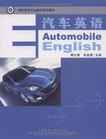汽车英语
出版时间:2009-6 出版社:外语教学与研究出版社 作者:顾云青,张金霞 主编 页数:126
前言
在中国,外语教学特别是英语教学这几年来一直是倍受关注的事情。尽管上至国家领导,下至学生和家长都给予了极大的关心和重视,政府和学校投入也很大,但教学效果却始终不能令人满意。每年各级各类学校都有大量外语毕业生走向社会,大学英语四、六级参考人数也逐步扩大到上千万之多,可学生口语不流利、专业知识缺乏、对国际贸易规则陌生等问题都令社会各界抱怨不已。这是为什么?是哪里出了问题?我们该怎么办? 近十年来,我国高等职业教育研究与实践已经取得了十分丰硕的成果,但仍然有一些基本问题没有解决,这和我们的英语教育颇有相似之处,那就是教育人才培养的效果与市场需求之间存在着系统性偏差,其表现为:高职院校毕业生的职业能力不符合用人单位的要求,社会对高职学生就业能力的认同度低;学生及家长对学校提供的课程不满意,认为在学校学习期间未能获得就业能力的有效培养。我们认为,在高职专业名称与社会需求接轨后,产生系统性偏差的主要原因是目前高职课程体系和培养模式不符合高等职业教育培养人才的内在规律,我们外语教育出现的问题也在于此!我们的外语教育内容和方法没有能够与时俱进,教学效果没能满足社会的需求。 高等职业技术教育应该以培养面向基层、面向服务和管理第一线需要的高等技术应用型人才为目标,职业技术教育以技术应用为主、以能力教学为核心。应按照“实际、实用、实践”的原则,改革专业教学内容、课程体系,制定各专业的人才规格和知识能力结构。高职教学内容必须强调实用性、针对性,必须根据就业需要有的放矢地选择教学内容,恰当处理好近期的就业“必需够用”和将来的发展“迁移可用”的关系,科学构建针对性强、能培养高等实用型人才的课程结构。高职高专的英语教学也必须遵循这个原则,这也正是本套教材编写的原则和特点。 本系列教材在全面贯彻《高职高专教育英语课程教学基本要求(试行)》的前提下,结合一线教学实际,突出了以下几个特点: (1)设置课程原则——面向行业。 (2)设定培养目标的原则——以能力培养为本位。
内容概要
本教材主要供高职高专汽车类专业的学生使用,具有如下特点: ●结合学生实际工作需求,全面介绍汽车构造、保养、理赔和营销等方面的知识。 ●内容编排既保证汽车专业知识的系统性,又注重提高其趣味性。 ●以培养阅读能力为主,兼顾口语交际能力和翻译能力的培养。 ●选材贴近生活,时代性强,语言真实地道。
书籍目录
Unit 1 History of the Automobile Text A History of the Automobile Text B Structure of the AutomobileUnit 2 Engine Text A Engine Text B Development of the Internal Combustion EngineUnit 3 Chassis Text A Chassis Text B Transmission SystemUnit 4 Electrical System Text A Electrical System Text B GeneratorUnit 5 Body Text A Automobile Body and Its Maintenance Text B Evolution of the Automobile BodyUnit 6 Service and Maintencance Text A Automobile Maintenance Text B New TechnologyUnit 7 Insurance and Claims Text A Automobile Insurance Text B Filing Claims Under Your Own PolicyUnit 8 Automobile Marking Text A Automobile Marketing Text B Auto Export Going HighKey to ExercisesGlossary ⅠWordsGlossary ⅡTerms参考文献
章节摘录
Electricity-powered Vehicles From 1832 to 1839, Scottish inventor Robert Andersondesigned a more practical vehicle that used a battery topower a small motor. This was hailed as a breakthrough,even though this vehicle was still very slow and oftenneeded to stop for a recharge. But the idea of electricity-powered vehicles did catch on. Streetcars and tramsused electricity for power and became the most populartransportation mode of choice in Europe and the U.S. inthe mid 1800s. Gasoline-powered Vehicles It was the invention of the gasoline-powered enginethat really brought a reliable and workable automobile tothe world. Gasoline-powered engines were not new; someof the first designs could be dated back to the late 1700s.Some inventors attempted to make a wagon or a carriagerun by a motor, but with moderate success. In 1885, Karl Benz built the first three-wheeledgasoline-powered car in Germany. In the following year, themilestone vehicle was built by Gottlieb Daimler, anotherGerman. He perfected the two-cylinder gasoline engine andattached it to a stagecoach, thereby producing the first four-wheeled motor vehicle in the world. And then, engineersand designers went on with refining and shaping the engineand vehicle designs. By the early 1900s, motor-poweredvehicles had become more popular than any other type ofvehicles. The First Vehicle Workshop In 1889, former woodworkers Rene Panhard andEmile Levassor in France set up the first workshop thatbuilt complete motor vehicles. They made each new car alittle bit different from its predecessors for years. Cars wererefined during processing. Improvements included movingthe engine to the front of the vehicle and designing a rear-wheel drive for better control of the vehicle.
图书封面
评论、评分、阅读与下载
用户评论 (总计4条)
- 这本书介绍了汽车的简史、几大总成以及相关的销售、保险等方面的英文阅读,简单易懂。
- 要是有更多的专业术语包含在里面就更好了
- 不错部门购买
- 整体的书比较简单,单词也比较少。当兴趣文章看了
